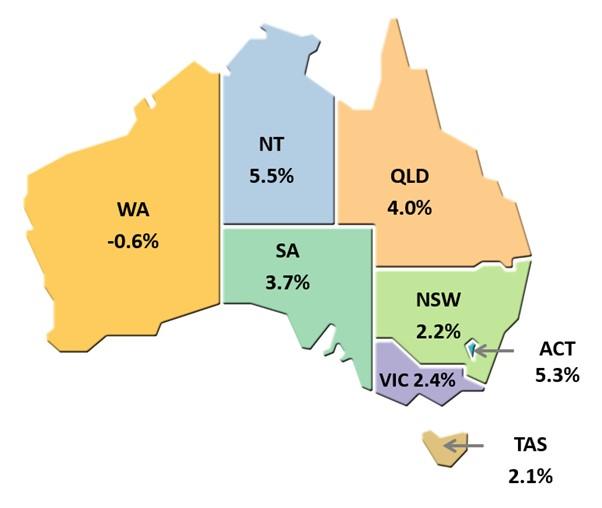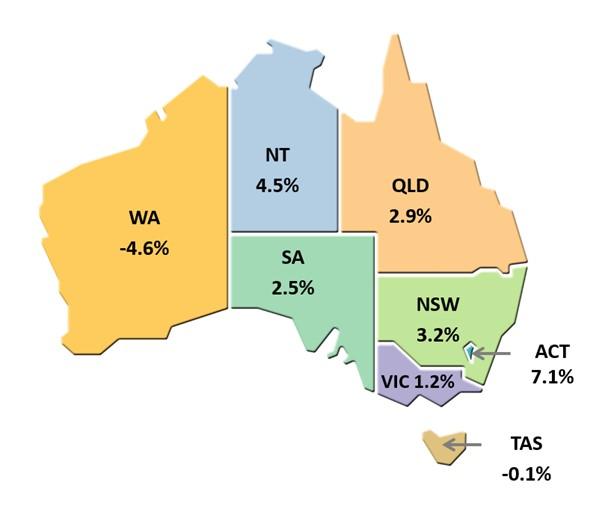Contributions to GVA growth (a) - Australian Capital Territory
[["1995-96","1996-97","1997-98","1998-99","1999-00","2000-01","2001-02","2002-03","2003-04","2004-05","2005-06","2006-07","2007-08","2008-09","2009-10","2010-11","2011-12","2012-13","2013-14","2014-15","2015-16","2016-17","2017-18","2018-19","2019-20","2020-21","2021-22"],[[-1.8999999999999999],[4.5],[5.4000000000000004],[8.0999999999999996],[4],[4.7000000000000002],[7.2999999999999998],[1.8],[1.3],[0.69999999999999996],[3.5],[4.5],[3.8999999999999999],[-1],[6.2999999999999998],[2],[3.3999999999999999],[0.10000000000000001],[-0.40000000000000002],[4.0999999999999996],[5.5999999999999996],[5.0999999999999996],[5.4000000000000004],[4],[4],[1.8999999999999999],[3.5]],[[-4.7000000000000002],[5.2000000000000002],[-3.5],[8.8000000000000007],[-3.2999999999999998],[0.10000000000000001],[3.7000000000000002],[-1.5],[-1.1000000000000001],[-5],[1.1000000000000001],[-2.2999999999999998],[3.6000000000000001],[-4.2000000000000002],[5.0999999999999996],[-2.8999999999999999],[1.7],[-1],[0.90000000000000002],[2.2000000000000002],[1],[3.7000000000000002],[1.7],[5.0999999999999996],[3.7000000000000002],[0.29999999999999999],[5.2999999999999998]],[[2.7000000000000002],[2.7000000000000002],[2.7000000000000002],[1.8],[3.1000000000000001],[3.1000000000000001],[2.7999999999999998],[3.2999999999999998],[3.3999999999999999],[3.3999999999999999],[3],[2.7999999999999998],[2.6000000000000001],[2],[2.6000000000000001],[2.2000000000000002],[2.6000000000000001],[1.6000000000000001],[1.3999999999999999],[1.2],[0.59999999999999998],[0.5],[0.5],[0.59999999999999998],[0.69999999999999996],[0.69999999999999996],[0.59999999999999998]],[[0.20000000000000001],[-3.3999999999999999],[6.2000000000000002],[-2.6000000000000001],[4.2000000000000002],[1.5],[0.80000000000000004],[0],[-1],[2.2000000000000002],[-0.5],[4],[-2.2999999999999998],[1.2],[-1.3999999999999999],[2.7000000000000002],[-0.90000000000000002],[-0.5],[-2.7000000000000002],[0.69999999999999996],[4],[1],[3.2999999999999998],[-1.6000000000000001],[-0.40000000000000002],[1],[-2.2999999999999998]]]
[]
[{"axis_id":"0","tick_interval":"","axis_min":"","axis_max":"","axis_title":"","precision":-1,"axis_units":"","tooltip_units":"","table_units":"","data_unit_prefix":"","data_unit_suffix":"","reverse_axis":false}][{"value":"0","axis_id":"0","axis_title":"","axis_units":"","tooltip_units":"(%)","table_units":"(%)","axis_min":null,"axis_max":null,"tick_interval":null,"precision":"-1","data_unit_prefix":"","data_unit_suffix":"","reverse_axis":false}]
